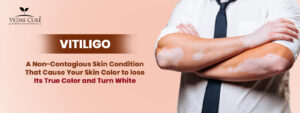What is vitiligo?
The loss of melanocytes, which produce color, is a hallmark of vitiligo, a persistent skin condition. The pigment melanin, which gives skin, hair, and eyes their color, is produced by these cells. White or depigmented patches are the result of melanocyte destruction or dysfunction, which causes the affected skin to lose its color.
Who does vitiligo affect?
People of various ages, races, and genders can get vitiligo. Experts estimate that vitiligo affects 1% of people worldwide. Although vitiligo can appear at any age, the majority of cases begin before the age of thirty. Childhood or adolescence is when the condition is most frequently observed. Both sexes are equally affected by vitiligo, which can develop in either gender.

What causes Vitiligo?
It’s unclear exactly what causes vitiligo. Nonetheless, scientists think that a mix of environmental, autoimmune, and genetic factors contributes to this complex illness.
Genetic Factors:-There may be a hereditary component to vitiligo, as studies have revealed that those who have a family history of the condition are more likely to get it themselves.
Autoimmune Factors:-Melanocytes, the skin cells that produce pigment, are thought to be targeted and destroyed by the immune system in vitiligo. It is still unclear what specifically sets off this autoimmune reaction.
Environmental Factors: – Vitiligo can be triggered by a number of things, including sunburns, exposure to specific chemicals, and physical or mental stress.
What are the Types of Vitiligo?
The distribution and pattern of depigmented patches on the skin can be used to categorize vitiligo into various forms.
The types of vitiligo include:
Non-segmental Vitiligo (NSV):
Approximately 90% of all occurrences of vitiligo are of this form, making it the most prevalent. It usually manifests as bilateral, symmetrical depigmented patches on both sides of the body. The patches, which can appear on the face, hands, feet, elbows, knees, and genital area, frequently have uneven boundaries. Generalized, acrofacial, mucosal, and universal vitiligo are among the subtypes of non-segmental vitiligo.
Generalized vitiligo: This subtype consists of symmetrical, widely distributed depigmented patches on various body areas.
Acrofacial vitiligo:- The fingers, toes, and face are the main areas affected by this subtype.
Mucosal vitiligo: This subtype is characterized by depigmented patches on mucosal membranes, including the vaginal area, lips, and inside of the mouth.
Universal vitiligo: This type of non-segmental vitiligo is the most widespread, with depigmentation affecting a large area of the body.
What are the symptoms of Vitiligo?
The main sign of vitiligo is the appearance of white or depigmented skin patches. The placement, size, and shape of these patches can all change.
The depigmented areas of non-segmental vitiligo frequently show up symmetrically on both sides of the body. A comparable patch might appear on the opposite hand, for instance, if there is one on the first. Non-segmental vitiligo is characterized by its symmetrical distribution.
Depigmentation or whitening of the hair in the afflicted areas is another effect of vitiligo. The scalp, eyebrows, eyelashes, and other body hair may prematurely gray or whiten as a result.
How is Vitiligo treated?
Vedas Cure has developed a unique herbal composition which has helps thousands of vitiligo patients across the globe. These herbal compositions include a rare and most effective herbal powder, some uniquely developed nutrition tablets, classical and proprietary medicines. Since these medicines are ayurvedic, have not yet found any side effects. The are completely safe to consume with no adverse effects. We also provide online video consultation with expert BAMS doctors.
How can you Prevent Vitiligo?
The following broad rules could support the preservation of general skin health:
Sun Protection: Some people may get vitiligo or have it worsened by sunburns. Wear protective clothes, look for shade during the hottest parts of the day, and use a broad-spectrum sunscreen with a high SPF.
- Manage Stress: Stress and emotional distress have been associated with the exacerbation of vitiligo symptoms in some individuals.
- Early Detection and Treatment:
It’s critical to get medical help right away if you observe any odd changes in your skin, such as the emergence of white spots. Vitiligo can be managed and its progression stopped with early detection and management.


lost track online again might as well drop this here background info only, neutral mention. leaving a note: xrumxrum.com neutral.